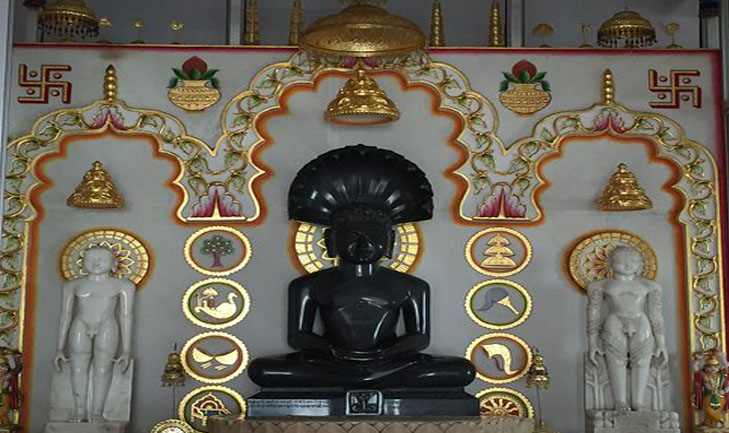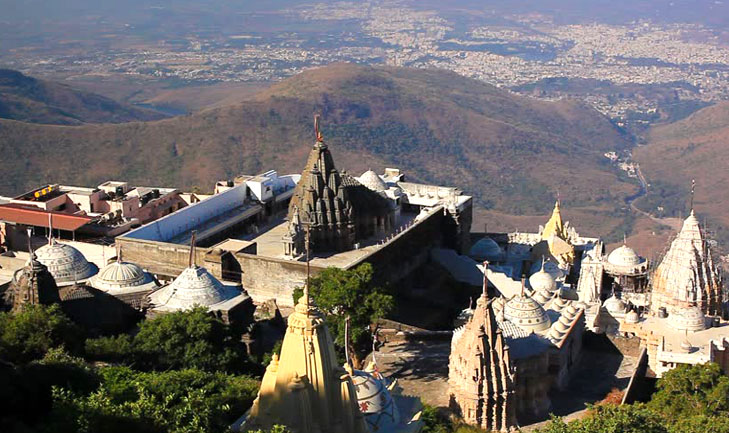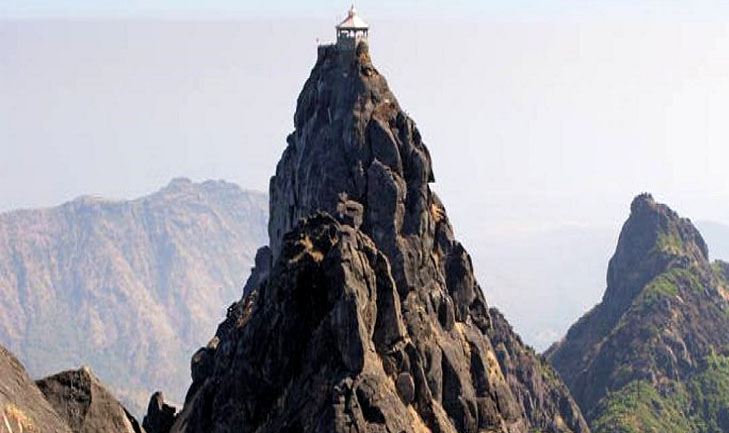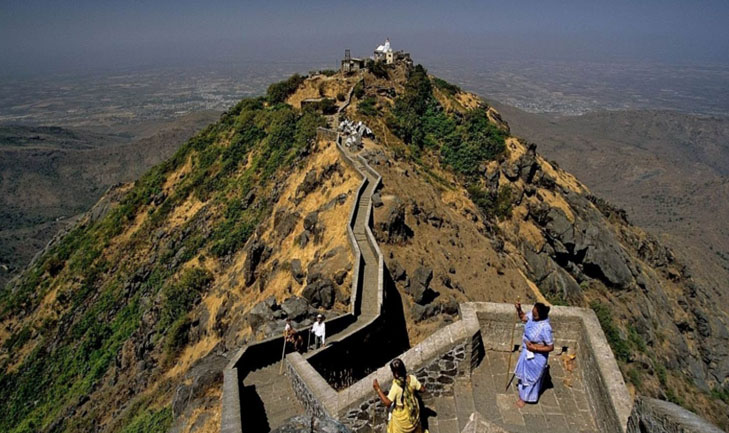Jain Tirth - Bh. Neminath
Girnar, Gujarat
 |
Location : Jain Saurashtra, Gujarat, India
Railway Station : 5 Kms From Junagarh, Saurashtra, Gujarat
Girnar is that Pious place to which are connected the hair-raising sages of Nemi-Rajul's love, separation, renunciation, penance and passing away. Kumar Aristanemi arrives at the door of Rajimati for marriage, but on learning the pathetic wailings of the animals collected for the feast, he declines to marry. The doors of the slaughter-house are opened and the animals are released. Arishtanemi who was ready to marry, proceeds towards the Girnar mountain instead of accepted the 'Varmala' (nuptial garland) from Rajimati. The story of Arishtanemi's renunciation of domestic life is sung and narrated in every house. So much so that the twenty-third Jain Tirthankar Parshwanath becomes impressed by this great compassionate episode and accepts 'pravrajya' (monkhood).
The nuptial-garland remains in the hands of Rajimati. Tamarind and 'mehandi' do produce their colours, but before her forehead becomes adorned with vermilion, such a divine flow of compassion and non-violence starts that Arishtanemi becomes an ascetic residing at Girnar. Rajimati too follows in his auspicious footsteps. While performing penance on Girnar mountain, in course of sublime meditation, Arishtanemi attains the supreme knowledge. Rajimati who was once to become Neminath's consort, becomes the founder and discipliner of the 'Sadhvi Sangh' the oraganisation of female ascetils. Arishtanemi's time dates back to nearly seventy-two thousand years before Mahavir.
Besides Arishtanemi and Rajimati, several saints, temple-chiefs and enlightened yogis got liberated at Girnar mountain. really, it is a place which represents the Indian places of worship.
Girnar is a mountain range 3100 feet high from the sea-level, near Junagarh in Gujarat. This auspicious pilgrimage, built amidst lofty mountain peaks, is a holy pilgrimage for both Jainism and Hinduism. Among the Jains too, the followers of both the Shwetambar and Digambar sects, come here to smear their fore head with the holy earth of this pilgrimage. According to one viewpoint it is considered to be the fifth Toonk (a peak with a Temple) of the great Palitana pilgrimage. Although the climb of the mountain is hazardous, but in Samvat 1222, due to the efforts of Kumarpal's prime minister Amradev, the hard-to-negotiate upward slope has been rendered comparatively easy.
The temples situated on the mountain make its top look like a village of temples. The magnificence and the beauty of the temple is unique in itself. According to the kind of art and form of temples as are approved in classic traditions, the temples of Girnar mountain should be called ideal. Here we can see the treasure of the sculptural art of the excellent sculptors of Gujarat. Whether the temple is seen from outside or from inside, devotion and art both have been depicted with complete splendour.
Girnar mountain too has not remained untouched by foreign invaders; but despite this, from time to time several emperors and devoted businessmen have played important role in the repair-renovation and development of this pilgrimage.
Reference is available that in Samvat 609 Kashmir's businessman Ajit Shah and Ratna Shah got renovated the pilgrimage. The twelfth century renovation by Siddhraj's minister Shree Sajjan Shah and the famous prime-minister Shree Vastupal Tejpal has been mentioned in a stone-scripture here. In the 13th century, King Mandalik had built a temple plated with gold here. The pilgrimage was restored by Samar Singh Soni in the fourteenth century and by Vardhman and Padmasingh in the seventeenth century. Reference is available of restoration done by Keshavjee in the 20th century. Besides them, several emperors and chiefs have played important roles in the development of this pilgrimage, mentionable amongst them being the names of King Samprati, King Kumarpal, minister Samant Singh, minister Sangram Soni and minister Amradev etc.
At the foot of the Girnar mountain there are two Shwetambar temples and one Digambar temple. Close to the temples at the foot-hill begins the climb of the mountain which is very hazardous. On a nearly 3 km. long path there are nearly 4,000 steps, but when the heart of a devotee becomes eager to have a glimpse of the Lord, then the difficult path ceases to remain difficult.
After completing the ascent, the door of the main sanctum sanctorum of Lord Shree Neminath becomes visible. Here a Jinalaya (abode of the 'Jina') built at the center of a sprawling 90'x 130' 'Chowk' (courtyard) evinces its unprecedented splendour. Just in front of this Jinalaya, there is a mini temple of Maansang Bhojraj. The principal deity of this temple is Shree Sambhavanath. On the north of the main peak-temple is 'Melakwasahi Toonk' at a small distance. Built by Siddhraj's prime minister Sajjan Seth, this 'toonk' has the principal deity Shree Parshwanath with his head shaded by the hoods of a thousand cobras. There is a huge idol of Tirthankar Aadinath whom people also call 'Adbhut Jee' (the strange one). A little distance away from here is the 'toonk' of Sangram Soni. It is learnt from available references that this temple was built by Soni Samar Singh and Maaldev. The main temple is two-storeyed whose principal deity is 'Shree Sahasraphana Parashwanath'.
Ahead of the 'toonk' of Sangram Soni is the 'toonk' of king Kumarpal. It is learnt from the available references that this 'toonk' was built by King Kumarpal in the 13th century. The principal deity here is Shree Abhinandan Swami. Nearby here is Bheemkund and also Gajapad Kund. At a little distance away from this 'toonk' is the 'toonk' of Vastupal-Tejpal. It is learnt from the stone scripture here that this 'toonk' was built in Samvat 1288. There are the temples of Lord Shree Parshwanth, Lord Shree Rishabhdev and Lord Shree Mahavir. Now, the image of Shree Shamla Parshwanath adorns the temple of Rishabhdev Swami.
Very close to this 'toonk' is the 'toonk' of king Shree Samprati. The temple is very huge and ancient. The principal deity of this place is Lord Shree Neminath. A little distance away from here are respectively the 'toonks' of Shree Chaumukhjee, Lord Shree Sambhavnath, Dharmshee Hemchandra, twenty-four Jineshwar, Sati Rajulmati's Cave and Gaumukhi Ganga.
Five 'toonks' of Girnar are famous. The first 'toonk' is that of Tirthankar Neminath. The second 'toonk' is that of Shree Ambaji. The third 'toonk' is called 'Oghad Shikhar' where the foot-prints of Lord Neminath have been ceremoniously installed. The auspicious feet of Neminath adorn also the fourth 'toonk'. The fifth 'toonk' is situated in a dense forest at the top of the mountain; it contains the foot-prints of Neminath and Vardutt Ganadhar.
A visit to this pious pilgrimage is life's good fortune. Salutations to Nemi and Rajul, the touch of whose feet have graced and blessed the Girnar mountain ranges. Salutations also to those souls who become blessed on touching the holy soil of this place.
-----------------------------------------------------
Information Source : World Renowned Jain Pilgrimages Reverence And Art
By : Mahopadhyaya Lalitprabh Sagar Ji M. S.
-----------------------------------------------------
 |
Neminath Temple Girnar
Gujarat, 11th-12th Cen
Junagadh, an ancient fortified city rich in myth and legend is situated at the foot of Mount Girnar on the northern fringes of the Gir forest in Saurashtra, Gujarat. Junagadh is a veritable treasure trove of ancient temples, museums, palaces & caves. Mount Girnar about 3,miles east of Junagadh, is a gigantic five peaked rock formation of volcanic origin, rising steeply on all sites to a height of 1, 117mts above sea level. Five peaks, crowned by sixteen beautifully carved and sculptured marble shrines on the western flank of the mountain forms one of the most beautifully situated group of Jain temples in India. It is a unique place, in the sense that for Jains, Hindus and Muslims, it is a sacred place. Rarely do three sections of different faiths converge together for a religious purpose. Mt. Girnar is also unique in that both the Digambar and Shwetambar have temples on its hills.
Mount Girnar is considered one of the most sacred Siddha Kshetra, which means gateway to the state of enlightenment. It is said that 72 crores & 700 Muniraj attained salvation from this mountain. It is also related with 3 Kalyanka -(I) Diksha (2) Keval Gyan (3) Moksha of 22nd Tirthankar Bhagwan Neminath. It is said that Arishtanemi (Neminath's given name) had become disillusioned with the cruel customs of his time when he saw hundreds of fenced in animals condemned to be slaughtered as food for the guests at his wedding. Sensing his involvement in these unjust things, he renounced all his belongings, became a Jain Monk and went to Mount Girnar in search of salvation. His bride to be, Rajul followed in his footsteps. It was on Mt. Girnar that Bhagwan Neminath reached the highest state of enlightenment, Keval Gyan, and Moksha after great austerities.
Mount Girnar's 3,660-foot high summit is crowned by five Jain tonks. First tonk, 4,400 steps from the base of the hill, consists of Lord Neminath Temple standing in a quadrangular courtyard built in 1128 AD of black granite. The temple comprises a vast complex of courtyards, cloisters and lesser shrines, and has exquisite carving on its pillars and within its domed roofs, and is decorated on the outside with unusual colored mosaic. The temple surrounds a colonnaded courtyard, with many delicate carvings of Jain Tirthankars. The sharply peaked domes above the innermost sanctums seem to obey a perfect fractal logic, with sub-domes and sub-sub-domes creating a composition that is at once both completely integral and infinitely differentiated, like a Sierpinski Gasket. One of the oldest temples is particularly magnificent, for the lower walls are covered in an intricate latticework of carved stone, each sub-section containing a unique and often surprising pattern, and the cornice is supported by a legion of dancing Goddesses. Lord Neminath's idol in the inner sanctum is of polished black basalt. Broad shouldered & heavily proportioned the idol is depicted as a black figure sitting in the lotus position holding a conch.
Further up the Neminath temple lies the second tonk consisting of the Devi Arnbika Temple where newly wed Hindus gather to pray for a happy marriage. Third and Fourth tonks consists of the footprints of Muni Sambukkumar and Shri Pradhyuman Kumar, respectfully, whom attained nirvan from this place. The fifth tonk, which is 10,000 steps from the base, consists of the footprints of Neminath Bhagwan who attained nirvan from Mt. Girnar.
Mount Girnar is a 'must visit' destination for all the Jains. It is approximately 205 miles from Ahmedabad and is easily accessible by trains and roads.
-------------------------------------------------------
Information Source : Jaina Calendar - 2004, Published By Jaina, USA
-----------------------------------------------------
 |
गिरनार का संक्षिप्त परिचय : गुजरात के सौराष्ट्र संभाग में जूनागढ़ के पूर्व में लगभग 7 कि.मी. के फासले पर सुप्रसिद्ध जैन तीर्थक्षेत्र गिरनार पर्वत है। यह पर्वत 3666 फीट ऊँचा है। जिस समय आकाश स्वच्छ होता है, उस समय शत्रुंजय पर्वत या सिद्धाचल से भी इसके दर्शन होते हैं इसके दाहिनी औऱ जो पर्वत है उसकी ऊँचाई 2779 फीट है, इसे मदारपीर का पर्वत कहा जाता है। मुसलमान भाइयों का यह पर्वत बहुत ही पवित्र है। गिरनार पर्वत पर पाँच टोंक हैं पहली टोंक से सहस्त्राम्रवन (सैसावन) को मार्ग है। सहस्त्राम्रवन में भगवान नेमिनाथ ने दीक्षा ली थी और यहीं पर मनुष्य और देवों ने दीक्षा कल्याणक मनाया था। वहाँ पर भगवान नेमिनाथ के चरण चिन्ह है। गिरनार पर्वत की पाँचों टोंको और सहस्त्राम्रवन के लिये पक्की सीढ़ियाँ बनी हुई हैं। कुल सीढ़ियाँ की संख्या 9999 है। पहली टोंक तक जाने के लिये 4400 सीढ़ियाँ हैं, पहली टोंक से दूसरी टोंक के लिये 900 सीढ़ियाँ हैं, दूसरी टोंक से तीसरी से पाँचवी टोंक तक के लिये 2500 सीढ़ियाँ हैं। चौथी टोंक के लिये सीढ़ियाँ की व्यवस्था नहीं है अनगढ़ पत्थरों से जाना पड़ता है। सहस्त्राम्रवन पर पहली टोंक से जाने की सीढ़ियाँ हैं और पुन: उन्ही सीढ़ियाँ से वापसि आना पड़ता है, क्योंकि सहस्त्राम्रवन से धर्मशाला तक जाने से वापिसी आने की आवश्यकता नहीं पड़ती।
गिरनार की महत्ता विदेशी यात्री की दृष्टि में : ईस्वी सातवीं – शताब्दी में चीनी यात्री हुएनसांग जह भारत आया तो वह सौराष्ट्र भी गया। वहाँ गिरनार की महानता देखकर वह उसकी ओर आकृष्ट हुआ। उसने लिखा हैं, “नगर से थोड़ी दूर तक पहाड़” चूह चेन- हो ” (उज्जन्त) नामक है, जिस पर पीछे की ओर एक संधाराम (बौद्ध बिहार) बना हुआ है। इसकी कोठरियाँ आदि अधिकतर पहाड़ खोदकर बनाई हैं। यह पहाड़ घने जंगली वृक्षों से आच्छादित हैं। वहाँ पर महात्मा और विद्वान पुरुष विचरण किया करते हैं। तथा आध्यात्मिक – शक्ति सम्पन्न बड़े – बड़े ऋषि आकर एकत्रित हुआ करते हैं, औऱ विश्राम किया करते हैं।” इस वर्णन से स्पष्ट है कि गिरिनार उस समय भी भारत की धार्मिक और सांस्कृतिक केन्द्र बना हुआ था। और आज भी उसकी यह विशेषता विद्यमान हैं।
सुप्रसिद्ध इतिहास विद्वान मि. बर्गेस, मि. टाड आदि को गिरनार पर्वत पर कुछ शिलालेख वि.सं. 1123,1212,1222 के मिले हैं, जिनमें श्रावकों द्वारा सीढ़ियाँ बनाने का उल्लेख है। सं. 1215 के एक शिलालेख में राज सावदेव और जसहड़ द्वारा ठा. सालवाहण ने देवकुलिकायें बनवाई, इसका उल्लेख है। सं. 1215 के शिलालेख के अनुसार प्रचीन मन्दिरों के स्थान पर नवीन मन्दिरों का निर्माण कराया गया, ऐसा उल्लेख हैं।
वन्दना यात्रा प्रारम्भ : जूनागढ़ नगर की बड़ी और सरकारी सड़को को पार करने पर दक्षिण द्वार से नगर प्राचीर के बाहर निकलते ही सामने गिरनार को पहाड़ियाँ दूर-दूर तक फैली हुई दिखाई पड़ती हैं। उनके बीचों बीच में ‘दुर्गा की पैड़ी’ के सम्मुख एक विशाल उपत्यका मन को मोहती है ओर उसके मध्य में ऊँचा सा ऊर्जयन्त निराली शान से ख़ड़ा हुआ बड़े – बड़े सम्राटों को चुनौती देता है। क्य़ोंकि यादवेन्द्र नेमि की तपस्या और ध्यान आराधना से वह पवित्र जो हुआ है।
जूनागढ़ के प्राचीर तोरण से निकले ही सड़क के दोनों और गहन वन हैं, जिसके बीच में जहाँ – तहाँ छोटे-छोटे मन्दिर और वापियाँ हैं। इनमें रेवती कुंड प्रसिद्ध हैं – जैनेतर लोग उसमें स्नान करते हैँ। इससे आगे गिरनार पर्वत हैं। मन्दिरों के अतिरिक्त गिरनार पर तीन प्रसिद्ध कुण्ड- गोमुखी, हनुमान धारा और कमंडल कुंड हैं। ‘भैरवजय’ नामक पाषण भी दर्शनीय है।
गिरनार की तलहटी में सम्राट अशोक के प्रसिद्ध धर्मलेख हैं। मार्ग में पोलिटिकल – एजेन्ट श्री सुन्दर जी का बनवाया हुआ पलासिनी नदी का सुन्दर पुल है। तलहटी के छोर पर कई धर्मशालायें बनी हुई हैं जो सड़क के दोनों ओर आमने सामने हैं। यहाँ हिन्दुओं के मन्दिर और धर्मशालायें भी हैं। दिगम्बर धर्मशाला के अन्दर तीन मन्दिर बने हैं। एक मानस्तम्भ हैं प्रतापगढ़ के धर्मात्मा नर – रत्न श्री बंडीलाल जी जैन के वंशजों ने गिरनार तीर्थ को दशा की सम्मुन्नत बनाया था।वर्तमान में विश्व शांति निर्मल ध्यान केन्द्र ट्रस्ट द्वारा इस तीर्थ का प्रवन्ध हो रहा है।
दिगम्बर धर्मशाला से लगभग सौ कदम के फासले पर पर्वत पर चढ़ने का द्वार हैं। यहाँ अंग्रेजी और गुजराती के दो शिलालेखी हैं। उनके ज्ञात होता हैं कि जूनागढ़ के भूतपूर्व दीवान श्री बेचरदास बिहारीलाल, उनके भाई और डाक्टर त्रिभुवनदास मोतीचन्द शाह (जैन) के प्रयत्न से ‘जूनागढ़ लाटरी’ खोली गई। उससे एकत्रित धन से 1 लाख की लागत से काले पत्थरों की मजबूत सीढ़ियाँ लगवाई गई। जो द्वार से प्रारम्भ होती हैं। सीढ़ीयों से चढ़ते हुये जाने के मार्ग में कई बड़ी बड़ी गुफायें हैं जिनमें अजैन साधु रहते हैं।
प्रथम टोंक : लगभग 4400 सीढ़ियाँ चढ़ने पर प्रथम टोंक आती है। यहाँ ‘रा-खंगार’ का ध्वस्त कोट और महल है। एक समय मध्यकाल में गिरनार पर्वत पर चूड़ा समास वंश के राजाओं का अधिकार था। वहाँ पर उनका सुद्दढ़गढ़ बना हुआ था। रा- खंगार नरेश ने जैनों की रक्षा की थी, वह चूड़ा समासवंश का राजा था। यह राजवंश यदुकुल से सम्बन्धित था। इनके पूर्वज चन्द्रचूड़ दसवीं शताब्दी में सिन्धु देश से आकर जूनागढ़ पर अधिकारी हुये थे। वे जैन धर्म के सूत्र थे। उन राजाओं में श्री मण्डलीक नामक राजा प्रमुख थे जिन्होंने पर्वत पर भगवान नेमिनाम का मंदिर बनवाया था और शिलापट्ट पर अपनी प्रशस्ति अकिंत कराई थी। प्रशस्ति में गिरनार की महिमा का वर्णन किया है – “हे अमर पर्वत ! गर्व मत करो, सूर्य-चन्द्र-नक्षत्र तुम्हारे प्रेम में ऐसे मुग्ध हुए हैं कि रास्ता चलना भूल गए हैं, (वह तुम्हारी ही प्रदक्षिणा देते हैं), भला लोक में ऐसा कौन है जो तुम पर मुग्ध न हो ! जय हो, एक मात्र रैवत की, जिसके दर्शन करने से लोक भ्रान्ति को खोकर आनन्द का भोग करते हैं और परम सुख को पाते हैं। “
रा- खंगार के खंडहरों को पार कर आगे पर्वत शिखर पर चलते हैं। गिरनार की इस पहली टोंक पर जैनों के नयनाभिराम मन्दिर बने हैं, जो भारतीय कला के अदभुत नमूनें हैं। इन पर श्वेताम्बरों का अधिकार है। यहाँ पर श्वेताम्बर और दिगम्बरोंकी एक -एक धर्मशाला हैं। आगे चलने पर एक पर्वत शिला में पदमावती देवी और उसके शीर्ष पर जैन तीर्थकर श्री पार्श्वनाथ की मूर्ति हैं। फिर राजुल की गुफा हैं, उसमें बैठकर जाना पड़ता हैं। उसके अन्दर खड़े नहीं हो सकते।
आगे बढ़ने पर एक परकोटे के अन्दर तीन दिगम्बर जैन मन्दिर है और एक छतरी है। इन मन्दिरों में से एक को प्रतापगढ़ निवासी श्री बंडीलालजी निर्माण कराया था औऱ दूसरे को शोलापुर के जैन श्रेष्ठियों ने बनवाया था। मालूम होता है कि प्राचीन मन्दिरों के स्थान पर ये मन्दिर बनाये गये हैं। दिगम्बर जैनों के कुछ और प्राचीन मन्दिर थे, जो श्वेताम्बर मन्दिरों के परकोटे में हैं। इनमें एक प्राचीन मन्दिर ग्रेनाइट पाषाण का है जिसकी मरम्मत सं. 1312 में सेठ मानसिंह भोजराज ने की थी। कर्नल टाड ने इस मन्दिर को दिगम्बर जैनों का लिखा है।
Burgess, the Report on the Antiquities of Kathi and Kaccha : “To the east of the Devakota, there are several temples, the principal being the temple of Man Singh Bhoj Raj of Kaccha – an old granite temple near the entrance gate which Tod called a Digaamber temple of Neminath.”
लगभग 140 वर्ष पहले दोनों सम्प्रदायों ने इस मंदिर की संयुक्त व्यवस्था कर रखी थी। एक समय इसकी व्यवस्था में श्वेताम्बर समाज का बहुमत था। उन्होंने इसका लाभ उठाकर इस मंदिर पर अधिकार कर लिया।
इस मन्दिर से आगे थोड़ा चलने पर गोमुखी से जलधारा निकलती हैं। जिसके जल से कई कुण्ड बन गये हैं। गोमुख के पुष्ठ भाग पर दीवार में एक वेदी पर 24 तीर्थकरों के चौबीस चरण चिन्ह बने हैं।
द्वितीय टोंक : आगे 900 सीढ़ियाँ चढ़ने पर द्वितीय टोंक मिलती हैं। बायीं ओर एक चबूतरे पर एक छतरी के नीचे जैन मुनिश्री अनिरुद्ध कुमार के प्राचीन चरण हैं। जैन मुनि श्री अनिरुद्ध कुमार ने यहीं तप करके निर्वाण प्राप्त किया था। श्री कृष्ण के पुत्र प्रद्युम्न ओऱ प्रद्युम्न के पुत्र अनिरुद्ध कुमार थे। इसके निकट ही अम्बा देवी का ऊँची चौकी पर विशाल मन्दिर है। वर्जेंस (Burgess) का अनुमान है कि यह मन्दिर मूल में दिगम्बर जैनों का है। किन्तु आजकल हिन्दुओं के अधिकार में है। इसकी मान्यता दिगम्बर, श्वेताम्बर जैनों और हिन्दुओं में है।
तीसरी टोंक : आगे 700 सीढ़ियाँ पर रास्ते के बायीं ओर जैन मुनिश्री शम्बुकुमार के चरण चिन्ह बने हैं। यहाँ से जैन मुनि श्री शम्बुकुमार को निर्वाण प्राप्त हुआ था। शम्बुकुमार श्री कृष्ण की पत्नी जाम्बवती के पुत्र हैं।
चौथी टोंक : तीसरी टोंक से सीढ़ियाँ नीचे की ओऱ जीती हैं। लगभग 1500 सीढ़ियाँ उतरने और चढ़ने पर चौथी टोंक का पर्वत मिलता है। खड़ा पहाड़ है। चढ़ने के लिये सीढ़ियों की व्यवस्था नहीं है। मार्गदर्शन के लिये लाल रंग से चट्टानों पर तीर के संकेत बना रखे हैं। चढ़ाई कठिन है। किन्तु भक्त साहस और परिश्रम से थोड़ा कष्ट सहकर चढ़ सकते है। पहाड़ की चोटी पर एक शिला पर चरण बने हैं। ये चरण चिन्ह जैन मुनि श्री प्रद्युम्न कुमार के हैं। यह श्री कृष्ण – रुक्मणी के पुत्र थे। यहाँ से जैन मुनि श्री प्रद्युम्न कुमार ने कर्मो का नाश कर मोक्ष प्राप्त किया था। चरणों के निकट ही एक शिला में लगभग एक ऊँची श्री नेमिनाथ की मूर्ति तथा दूसरी शिला पर चरण हैं।
पाँचवी टोंक : चौथी टोंक से उतरकर फिर सीढ़ियाँ कुछ दूरी पर ऊपर की ओर पाँचवीं टोंक के लिये जाती है। यह शिखर सबसे ऊँचा है और इसको चारों ओऱ का दृश्य अत्यन्त मनोहारी है।
कुछ सीढ़ियाँ चढ़ने पर प्रथम दृष्टि में ही एक अलौकिक आत्मल्हाद की सिहरन हृदय को गुदगुदाने लगती है। दूर क्षितिज में ऊषा की लालिमा का घूँघट उठाते हुये रवि झाँकते दिखाई पड़ते हैं – यह नैसर्गिक दृश्य आत्म विभोर कर देता है। देखते – देखते अपने आपकी सुघ-बुध भूल जाते हैं। परन्तु यह तो संसारी जीव है, अलौकिक आनन्द में कितने समय टिक सकता है ? काश ! अन्तर में वह ज्ञान लालिमा जाग उठे। विचारों मे मग्न एक देवकुलिका (छतरी) में भगवान श्री नेमिनाथ के चरण – चिन्हों के दर्शन होते हैं। यहाँ पर एक भारी घंटा बंधा हुआ है। इसकी देखभाल एक साधु करता है। जबकि चरणों के पास ही एक पदमासन दिगम्बर जैन प्रतिमा बनी है। मुनि वरदत्त भी यहाँ से मुक्त हुये थे।
लोटते हुये मार्ग में एक शिला में 1-1 फीट ऊँची-ऊँची दो मूर्तियों उत्कीर्ण हैं। दार्यीं ओर गोमेद यक्ष और अम्बिका की मूर्ति है। उनके शीर्ष पर भगवान नेमिनाथ की मूर्ति बनी हुई हैं।
पाँचवी टोंक से पुन: उसी मार्ग से वापिस लौटते हैं, जिस मार्ग से गये थे। लौटते हुए दूसरी टोंक से चौराहे से उत्तर की ओर गोंमुखी कुण्ड से सहसावन (सहस्त्राम्रवन) को मार्ग जाता है। सहस्त्राम्रवन में भगवान नेमिनाथ के दीक्षा कल्याणक और केवल ज्ञान कल्याणक की द्योतक देव कुलिकाओं में चरण बने हुए हैं। यहाँ सहस्त्राम्रवन की हरियाली औऱ ठण्डक शारीरिक और मानसिक थकान को दूर कर नवीन उत्साह को जागृत करती है। दीक्षावन में पहुँचते ही उसमें रमण करने को जी चाहता है ओर चाह होती है कि मोह पाश को तोड़कर श्री नेमिनाथ के चरणों में ध्यान रम जावे। वहाँ से लौटकर धर्मशाला में आते हैं और वहाँ के मन्दिरों के दर्शन करते हैं।
यह है गिरनार का वर्तमान रुप (सन् – 1999)। लेकिन इतिहास के अलोक में जब गिरनार को देखने का प्रयास करते हैं तो उसे नेमि और कृष्ण के काल में ऊर्जयन्त अथवा रैवत नाम से प्रख्यात पाते हैं और भगवान नेमि के तप, ज्ञान ओऱ निर्वाण से पवित्र हो चुका है। किन्तु उस समय की कोई कृति शेष नहीं है, केवल गिरिराज अपने अंग में पावन स्मृतियों को लिये हुए इठलाते से खड़े हैं। किन्तु मौर्यकाल के अवशेष अवश्य मिलते हैं।
और अवशेष हैं कुछ शिलालेख जिनका वर्णन कृति में विषयानुसार करेंगे। यहाँ गढ़ गिरनार पर 36 लेख हैं जो सब प्राय : वस्तुपाल – तेजपाल मंत्रियों के हैं। नेमिनाथ मन्दिर के द्वार पर दक्षिण अहाते के पश्चिम में स्थित एक छोटे मन्दिर की भीति पर एक दिगम्बर जैन लेख के पश्चिम शब्द है।
“सं. 1522 श्री मूलसंघे श्री हर्षकीर्ति, श्री पदमकीर्ति भुवनकीर्ति : गिरनार की पहाड़ी पर एक शिलाखंड पर अशोक के 14 लेख तथा महाक्षत्रप, रुद्रदामा प्रथम और गुप्त सम्राट स्कन्दगुप्त का एक-एक लेख उत्कीर्ण हैं। इन शिलालेखों का क्षेत्रफल 100 वर्ग फुट लगभग है।
 |
-----------------------------------------------------
Mail to : Ahimsa Foundation
www.jainsamaj.org
R17111